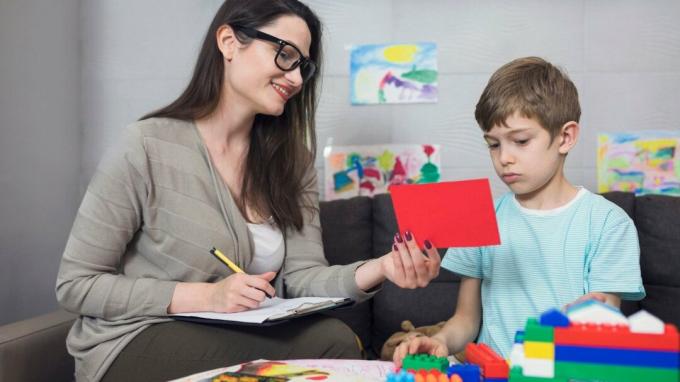The 5 differences between child and adult psychotherapy (explained)
In recent years there have been many changes experienced in society in terms of mental health. Talking about psychological problems is no longer a taboo subject, so that more and more people are inclined to go to a professional to receive the help they so badly need.
If in the past it was difficult to talk about mental health as an adult, the situation for children and adolescents was even more complicated. Until not long ago, the little ones were considered second-class people, without the right to complain or have an opinion like the older ones. This has been determined, among other things, by the myth of happy childhood.
This alludes to the general belief that the first years of life are always happy and innocent, an idea that has permeated the collective thought. However, the reality is that emotional distress can appear at any time in life, including childhood. In other words, being a child does not guarantee feeling good, so minors also often need professional help.
The recognition of psychological problems in childhood has implied a growing demand for professionals specialized in child and adolescent psychotherapy.. However, psychologists who work in this field work in a completely different way from those who focus on accompanying adult patients. This is because there are important differences between the two types of therapeutic processes, which we will discuss in this article.
- We recommend you read: "Why is play important in child therapy?"
How is psychotherapy for children and adults different?
Next, we are going to discuss some important differences between child and adult psychotherapy.
1. Participants in the therapeutic process
In therapeutic processes with adults, generally the professional will carry out his work only with the client who has demanded the services. Occasionally, a family member who wishes to collaborate to help the patient may be included in a session, but it is not essential. In fact, many people prefer not to involve partners and family members in their processes because they do not want to worry them, because they have not told them that they are going to therapy or because they simply do not have a good relationship with them.
On the contrary, the therapeutic process with children and adolescents necessarily requires work on several different axes.. Essentially, the professional will have to include the parents or legal guardians in the treatment, since they are the ones who have the responsibility for that minor. In addition, with minor patients an indirect intervention is often carried out, so that provide guidelines for adults to modify possible problematic dynamics that harm that child or Teen.
Added to this, it is also usually advisable to have the collaboration of the school, since the patient spends many hours a day in this space. Thus, frequent contact with the school counselor is common for a child and adolescent therapist. In this way, the intervention to help the patient is coordinated taking into account all the important areas in which he operates.
2. Decision to go to therapy
When an adult goes to therapy, he always does it of his own free will. It is possible that the opinion of third parties influenced his decision, but he is the one who has the last word. However, this is not the case at all when we talk about children and adolescents. When the patient is a minor, he always goes to therapy because his parents have decided so. If his parents are not satisfied, he will hardly be able to see a professional.
In fact, child and adolescent therapists must have a thorough understanding of the legal nuances and all that surrounds adult consent. When the parents are separated, it is relevant to take into account that both will have to express their consent in writing unless one of them was deprived of parental authority for any reason.
The fact that a child or adolescent goes to a consultation without this being her decision implies that the professional will have to work to form a good therapeutic bond with him. Although there are those who go to the psychologist without inconvenience, others may present themselves in the first session with a lot of rejection. The therapist will have to achieve a comfortable and reliable climate, so that the patient feels in tune with him. Although bonding difficulties can also arise with adults, the reality is that with them at least one has the certainty that they are in the consultation because they want to.

3. game versus words
Therapy with children and adolescents should be based on game dynamics, movement and symbolism. On the other hand, with adults, words are usually used as the central element, so that the sessions take the form of a conversation. Child and adolescent therapists should always have their office full of dolls, games and open spaces that allow them to move, play, have fun and connect.
Treating a child as if it were a miniature adult is a guarantee of failure, since her reasoning is not abstract like that of an older person.. The little ones have concrete reasoning, which focuses on the tangible and the particular. Especially before the age of 7, they may have difficulty making inferences and keeping their attention focused on something for a long period of time.
The thought of him can mix fantasy with reality, in addition to having an egocentric aspect in early childhood. It is not until the age of twelve that more abstract forms of reasoning begin to take shape. Knowing these particularities is necessary for the therapist to learn to deal with child patients. The way of working with the little ones is therefore totally different from adult therapy.
4. Particularities of the evolutionary moment
As we discussed in the introduction to this article, only a few years ago children were considered miniature adults. However, nothing is further from reality. Problems that are out of the ordinary in an adult may be perfectly natural in childhood or adolescence, so it is key that the professional has knowledge of evolutionary psychology.
To understand this point we will give an example. An adult person may be afraid of being alone or meeting new people.. It is a fear that prevents her from living her life normally and causes her a lot of suffering, since she is expected to be independent and able to maintain normal interactions with different people.
However, fear of strangers and separation anxiety are natural reactions in babies and children up to three years of age. These evolutionary fears are not accidental, but constitute survival mechanisms that favor the proximity of human offspring with their caregivers. As you can see, the same fear is a reason for problems in an adult, while in a small child it is an indicator that development follows a normal course.
5. Reason for consultation
The reason for consultation is something like the main reason that has led the patient to ask for help. With adult patients, one problem may be emphasized initially, and deeper issues may be uncovered as therapy progresses. In the case of children and adolescents, the reason for consultation should be asked of their parents and of them separately. This is important because, sometimes, there is no congruence between what they say about each other.
This is because parents are great experts in identifying problems in externalizing behavior, that is, what others can see. However, many times adults are oblivious to internalizing symptoms, that is, those that belong to the internal world of the child and that are not always evident to others.. For this reason, interviews with both parties will allow us to compare the information and better understand what the real demand is.

conclusions
In this article we have talked about some differences between child and adult therapy. Just a few years ago, children were considered miniature adults. In addition, they were expected to be naturally happy, since childhood has always been associated with innocence and carelessness. However, the reality is that children and adolescents also have problems and have the right to suffer like adults. Beginning to recognize their discomfort has led to a growing demand for psychology professionals specializing in childhood and adolescence.
However, the development of therapy with both types of populations is radically different. Doing therapy with the little ones involves building an interaction based on play, symbols, movement, drawing, etc. On the other hand, with adults the focus is usually on the word, so that the sessions apparently flow like a conversation. It is also important to take into account that in child and adolescent therapy, parents and the school must be involved, since these axes are part of the life of the child.. In addition, children are not the ones who decide whether or not to attend the session, which can hinder their motivation and bonding with the professional at the beginning.

